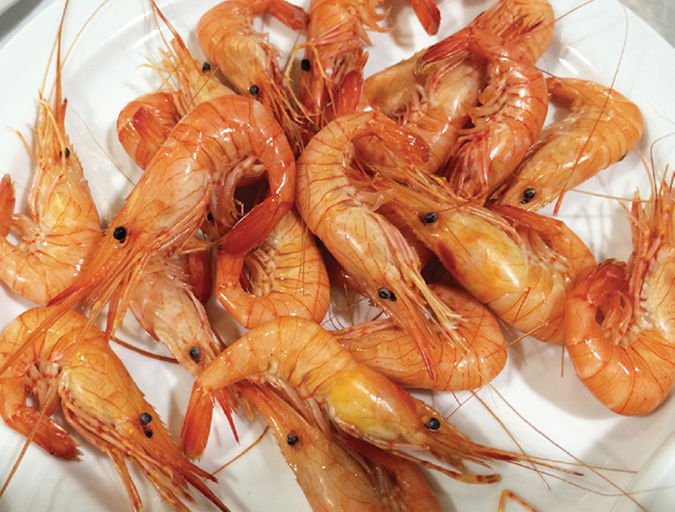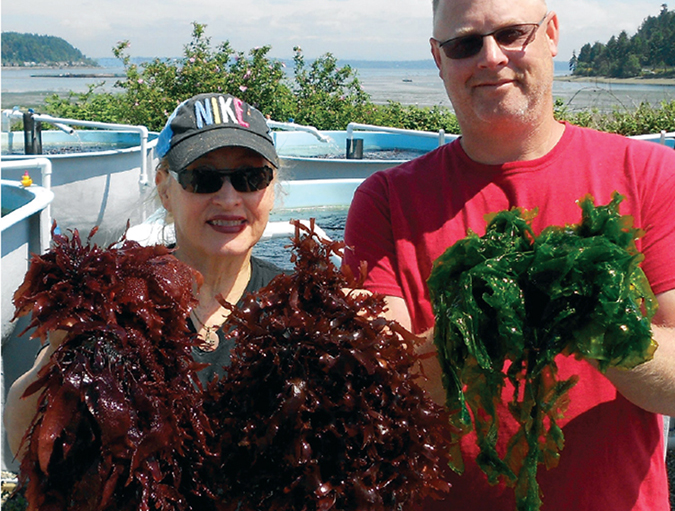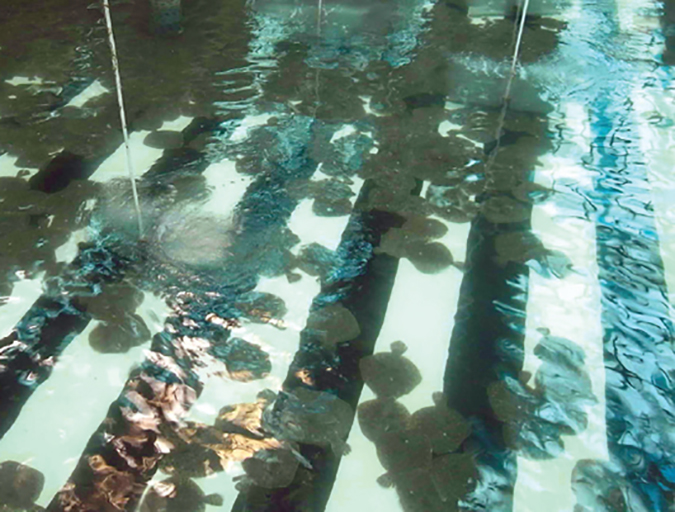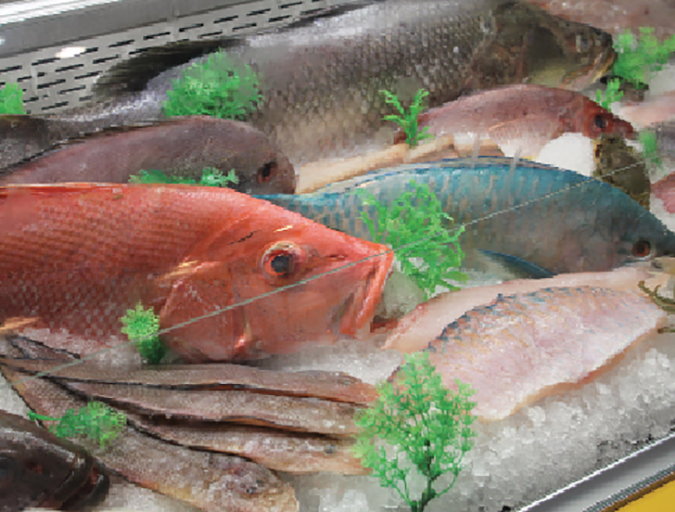Adding sea lettuce to diets can make flavors and aromas more ‘sea-like’

Organoleptic attributes such as flavor, taste and aroma are among the most important factors that influence consumer acceptability and demand for fish products. While the organoleptic attributes of farmed fish are generally considered adequate, farmed fish has sometimes been described as bland and devoid of desirable flavor qualities, especially for freshwater fish. Consumers have identified farmed fish as less complex and lacking “sea-like” or “sea-fresh” flavors and aromas, and often describe farmed fish as organoleptically inferior to their wild-caught counterparts.
Nutrition, organoleptic qualities
Aquaculture is primarily focused on the efficient production of biomass, with much less consideration given to the organoleptic quality of the harvested product. This is perplexing, given that aquaculture provides significant opportunities to intentionally influence or manipulate organoleptic attributes prior to harvest. This can enable farmers to better meet market preferences and expectations while also increasing financial returns.
It is well recognized that nutrition plays an important role in shaping the organoleptic properties of fish, as key flavor and aroma compounds are principally derived from the diet. Wild fish often have a very diverse diet, which brings about the characteristic complexity and distinctive flavor commonly associated with wild-caught marine fish.
Fish grown in aquaculture systems, however, are typically fed manufactured diets that are principally formulated to maximize somatic growth right up to the point of harvest. Although these diets utilize wild-sourced materials, fish reared in aquaculture systems lack the natural diversity of wild diets. This may be the principal cause of such a noticeable organoleptic difference from wild-caught fish.
In addition, as manufacturers seek to reduce wild-sourced ingredients and/or incorporate terrestrial-derived ingredients, organoleptic quality issues are likely to become more prevalent in aquaculture, as such diets may be low in or completely devoid of key flavor compounds.
Finishing diet study
The authors explored the application and potential use of a short-term finishing diet that could alter the flavor, aroma and taste of freshwater-reared fish prior to harvest. Finishing diets are commonly used in aquaculture to modify attributes that have high consumer appeal. The most notable applications are flesh color or restoring desirable fatty acids in fish reared on plant-based diets, but their application for the purposes of organoleptic manipulation is not well explored.
Lates calcarifer, known as Asian seabass in tropical regions or barramundi in Australia, was selected as a model species to assess the efficacy of an organoleptic finishing diet. In Australia, farmed barramundi are generally acknowledged as organoleptically adequate, although it is well known that wild-caught counterparts possess significantly stronger marine or sea-fresh characteristics and typically achieve a higher market price.
Marine macroalgae or seaweeds are high in numerous flavor compounds, especially those responsible for the “sea-fresh” and “sealike” flavors and aromas that typically characterize wild-caught marine fish. These compounds are passed up the food chain and eventually accumulate in higher-order predators like carnivorous fish. Given this information, the use of the marine seaweed Ulva ohnoi, more commonly known as sea lettuce, was trialed.
The seaweed was initially collected from settlement ponds on a prawn farm, where it was grown to reduce nutrient discharge. Following collection, the sea lettuce was further grown for several weeks, harvested, oven dried and milled to a fine powder. The seaweed was combined with a milled commercial growout diet to produce feed pellets with varying inclusion levels of seaweed: from a control with no seaweed to 10, 20, 30 and 50 percent.
Forty-five, 1-kg barramundi from a commercial farm were stocked in 15, 500-L fiberglass tanks at 3 fish/tank. The tanks were randomly allocated one of the five diets such that a single diet was fed to three tanks and a total of nine fish. Fish were fed to satiation daily. Feed intake was measured to evaluate the palatability of each diet.
A single fish was harvested from each tank after seven, 14 and 21 days of feeding using industry standards. The fish were then filleted on both sides and immediately frozen. After two weeks of storage, the fillets were subjected to descriptive sensory assessment by a panel consisting of nine trained people.
Only four diets were assessed, as the diet containing seaweed at the 50 percent inclusion level clearly impacted palatability. The feed intake of fish on this diet was only one-third of that observed in fish fed the control diet. Barramundi fed the 10 percent seaweed diet had a sensory profile similar to that of barramundi fed the reference diet (Figure 1).
Clear differences in the organoleptic profile were apparent in fish fed the 20 and 30 percent diets. Significant increases were observed in the intensity of crablike/seafood flavor, crablike aroma, crablike aftertaste, sweet aroma and flavor complexity (Figure 1). In general, the intensity of these attributes continued to increase with feeding time, being most intense after 21 days of feeding.

Testing for key compounds
Following these results, the authors subjected smaller tissue samples from fillets to instrumental analysis, searching for several well-known key flavor and aroma compounds. Only one compound, dimethylsulphide, showed a clear association with the change in organoleptic attributes.
Dimethylsulphide is regarded as the source for a major smell of the sea often characterized as a sort of “fishy, tangy, sea-fresh smell.” This compound was eight times more elevated in the tissue of barramundi fed the 30 percent seaweed diet than in fish fed the control diet and was commensurate with a threefold increase in crablike/seafood flavor.
Masking off-flavors
The authors recently studied the ability of these diets to mask or disguise off-flavors that result in muddy/earthy/musty taints. Although these flavors are generally regarded as natural characteristics of wild-caught freshwater fish, the occurrence of these flavors can be extremely problematic in freshwater pond farming. Off-flavor fish are considered spoiled and unmarketable, resulting in significant losses to farmers. Episodes of off-flavor tainting have previously been identified in the pond culture of barramundi in northern Australia.
Following an approach similar to that outlined above, the authors fed two groups of fish a control diet containing no seaweed and another diet containing 20 percent seaweed. Following four weeks of feeding, the fish were intentionally tainted with geosmin at three different intensities: low, 0.5 ug/kg geosmin; low to medium, 1.4 ug/kg geosmin; and medium to high, 5.2 ug/kg geosmin. The fish were then harvested and again subjected to descriptive sensory assessment.
Results demonstrated that the 20 percent seaweed diet had the capacity to mask off-flavor taint resulting from geosmin at low to medium levels, while halving the perception of such off-flavors at medium to high levels (Figure 2).

Perspectives
Feeding freshwater fish a diet incorporating sea lettuce, which is rich in flavor compounds, can enhance and add flavor complexity to the fish. The flavors and aromas seem to be principally marine or “sealike,” and this practice may present a way of producing freshwater fish that have organoleptic similarities to those of wild-caught marine fish. Although promising, this research is still at a very rudimentary stage. If an organoleptic finishing diet is to be useful in a commercial setting, there is still much we need to learn.
Now that you've reached the end of the article ...
… please consider supporting GSA’s mission to advance responsible seafood practices through education, advocacy and third-party assurances. The Advocate aims to document the evolution of responsible seafood practices and share the expansive knowledge of our vast network of contributors.
By becoming a Global Seafood Alliance member, you’re ensuring that all of the pre-competitive work we do through member benefits, resources and events can continue. Individual membership costs just $50 a year.
Not a GSA member? Join us.
Authors
-
Guy Carton, Ph.D.
College of Marine and Environmental Sciences
Centre for Sustainable Tropical Fisheries and Aquaculture
James Cook University
1 James Cook Drive
Townsville City, Queensland 4811 Australia -
Igor Pirozzi, Ph.D. and Ben Jones, Ph.D.
College of Marine and Environmental Sciences
Centre for Sustainable Tropical Fisheries and Aquaculture
James Cook University -
Richard Smullen, Ph.D.
Ridley AquaFeeds Ltd.
Narangba, Queensland, Australia
Tagged With
Related Posts

Intelligence
Warning: Shrimp salad may contain shrimp
Crustaceans, fish and any food that contains protein have the potential to cause allergic reactions in some individuals. To protect consumers, seafood businesses must stay abreast of changing regulations.

Intelligence
Land-based macroalgae farming
Land-based cultivation of macroalgae can minimize impacts on wild macroalgae stocks while reducing harvest costs and controlling quality. Integration of macroalgae with land-based fish culture systems could reduce capital and operating costs.

Aquafeeds
Turbot growth performance on soy-based feeds
Turbot are typically fed diets containing 45 to 65 percent fishmeal. In a study that gave turbot feed with 40 percent soy protein concentrate, the fish had decent growth and excellent survival.

Intelligence
Food is abundant, yet people are starving
While significant numbers of people are undernourished, an increasing number of people are overweight. The divide between recommendations and results is marked, so we must learn more about food production and change our behaviors.



